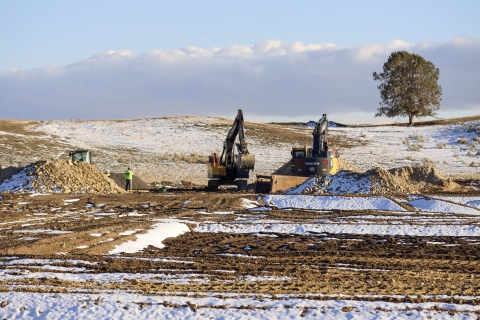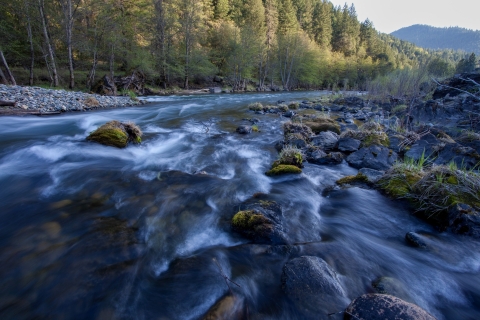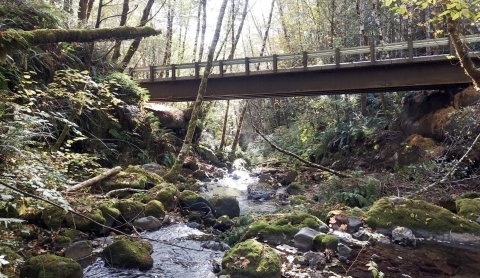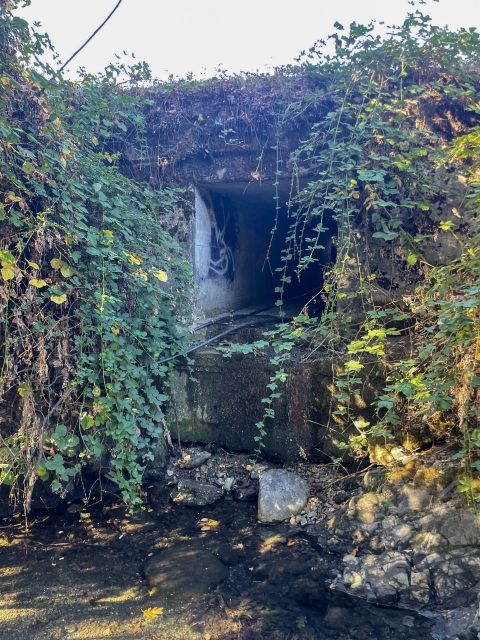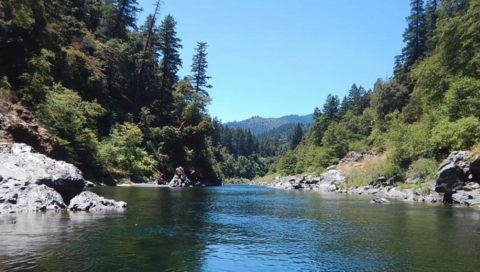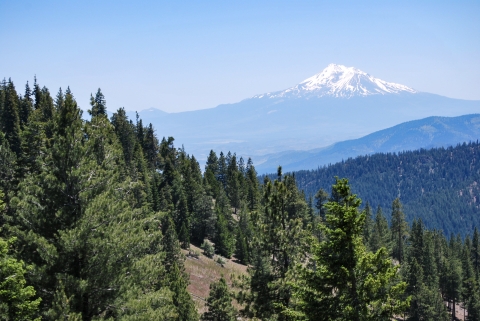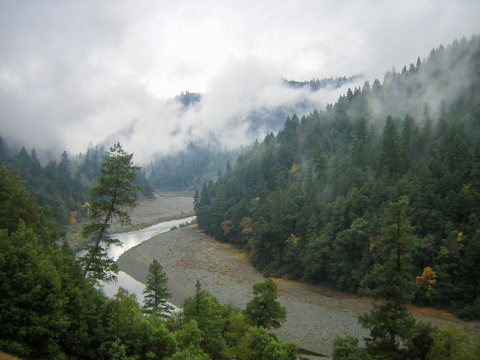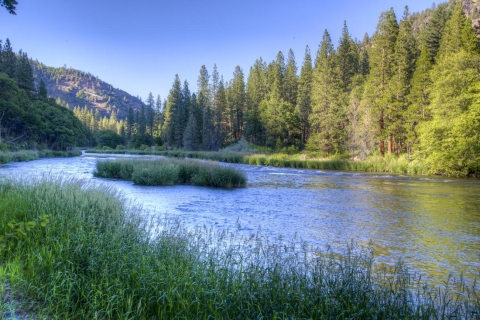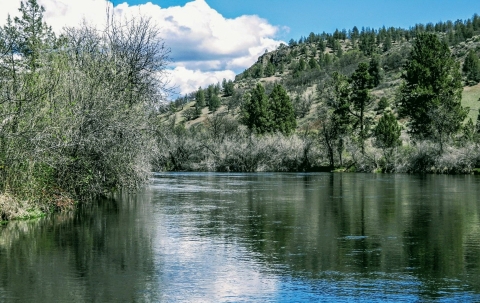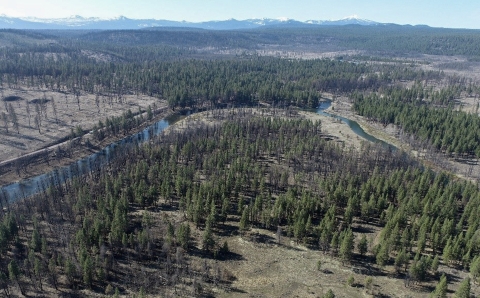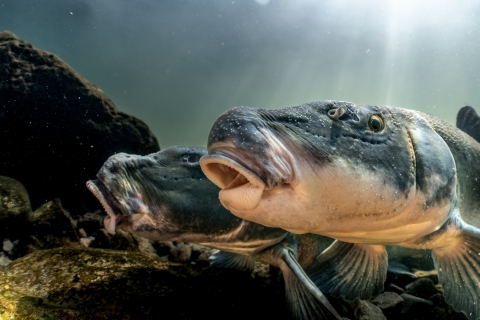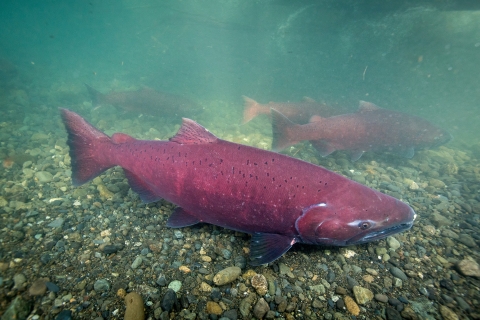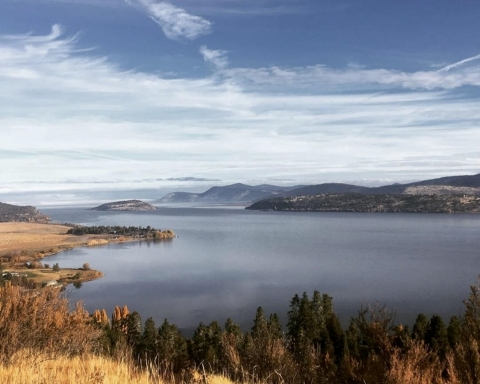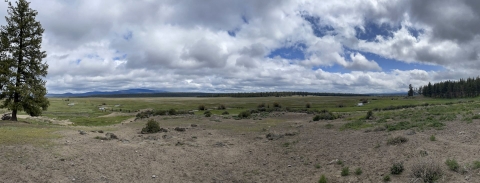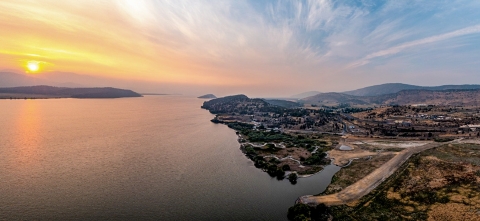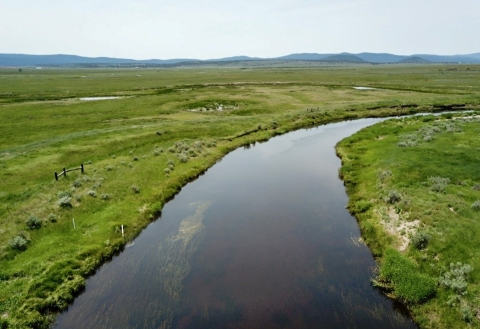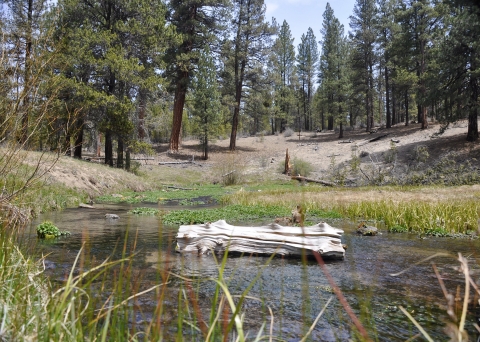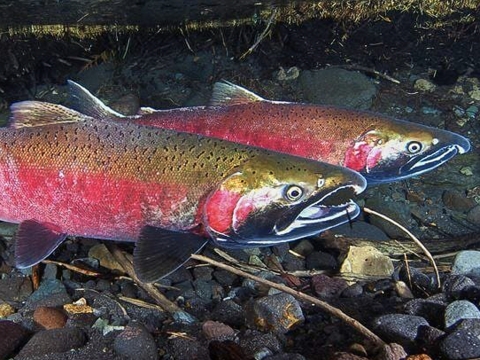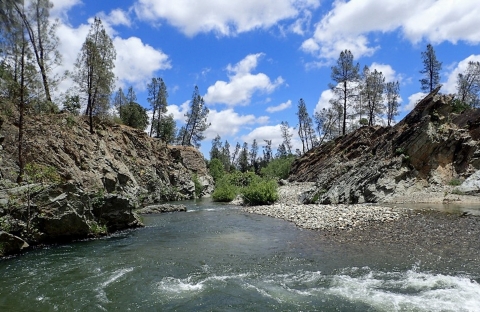The Bipartisan Infrastructure Law, enacted in November 2021, is a once-in-a-generation investment in the nation’s infrastructure and economic competitiveness. The U.S. Fish and Wildlife Service was directly appropriated $455 million, with the Klamath Basin set to receive $162 million of this investment over five years to restore the regional ecosystem and repair local economies.
The Klamath Basin’s fragile ecosystem depends on collaborative partnerships among a wide variety of stakeholders and the development of holistic solutions. Bipartisan Infrastructure Law Bipartisan Infrastructure Law
The Bipartisan Infrastructure Law (BIL) is a once-in-a-generation investment in the nation’s infrastructure and economic competitiveness. We were directly appropriated $455 million over five years in BIL funds for programs related to the President’s America the Beautiful initiative.
Learn more about Bipartisan Infrastructure Law funding will help rebuild communities by investing in the ecological infrastructure of the Klamath Basin while working with Tribes, states of California and Oregon, local officials, private landowners, farmers and ranchers and other partners to improve conditions for fish, birds, and local communities.
To date, the Service has allocated almost $90 million in Bipartisan Infrastructure Law funding to support 41 projects driven by Tribes, partners and communities addressing local and regional needs. These wide-reaching conservation projects help to create fish habitat, monitor water quality, quantify ecosystem recovery, improve hydrologic models, and better track salmon and sucker populations. The Service is also using Bipartisan Infrastructure Law funding to install pumping stations to improve water availability for national wildlife refuges and farms, support post-fire stream restoration activities in the Sprague River watershed after the Bootleg Fire, and restore natural springs. These projects build a more resilient basin that can support the communities that call it home.
The Service is also investing in a significant expansion of the Klamath Falls National Fish Hatchery to prevent the extinction of two federally listed species: the Lost River and shortnose sucker (c’waam and koptu), which are found only in the Klamath Basin. Since 2022, the Service has allocated $30 million in Bipartisan Infrastructure Law funds that will result in a completed hatchery that will advance sucker recovery and reduce community conflict over water needs for the ecosystem and local agriculture. These investments at the fish hatchery are working in parallel with funding for the Klamath Tribes’ own sucker rearing and salmon reintroduction programs.
“We are rebuilding the ecological infrastructure of the Klamath Basin with this once-in-a generation investment,” said Service Pacific Southwest Regional Director Paul Souza. “With the help of our partners in the Basin, we are gaining momentum towards our goal of a drought resilient and restored ecosystem in the Klamath Basin.”
View this content in an interactive StoryMap.
Expansion of the Klamath Falls National Fish Hatchery
FY22-FY25 Funding $30,000,000
The Klamath Falls National Fish Hatchery investment will increase rearing capacity and help prevent extinction of two federally listed species found only in the Klamath Basin, the Lost River and shortnose suckers (c’waam and koptu). This $30M will provide full funding to complete the construction of the hatchery, which is anticipated by 2027. Once the hatchery is completed, it will have the capacity to rear 60,000 suckers annually in support of the recovery of these highly imperiled species.
Yurok Tribal Capacity
FY22 Funding $235,043
The Yurok Tribe Fisheries Department (YTFD) has made enormous contributions to the restoration of the Lower Klamath River Basin. This funding will add capacity so that the Tribe can continue to meet and expand its priority fish restoration efforts. The position will be funded for two years.
Partner: Yurok Tribe
Waukel Creek and Junior Creek Culvert Replacement
FY22 Funding $615,153
FY23 Funding $1,000,000
Funds for this project will replace two undersized culverts, elevate roadways, remove invasive species invasive species
An invasive species is any plant or animal that has spread or been introduced into a new area where they are, or could, cause harm to the environment, economy, or human, animal, or plant health. Their unwelcome presence can destroy ecosystems and cost millions of dollars.
Learn more about invasive species , and plant native vegetation. The proposed culvert design sought to maintain the positive existing tailwater condition for fish passage fish passage
Fish passage is the ability of fish or other aquatic species to move freely throughout their life to find food, reproduce, and complete their natural migration cycles. Millions of barriers to fish passage across the country are fragmenting habitat and leading to species declines. The U.S. Fish and Wildlife Service's National Fish Passage Program is working to reconnect watersheds to benefit both wildlife and people.
Learn more about fish passage while increasing the ability to pass high flows. Additionally, a portion of the existing culvert area on Junior Creek will be converted to an open channel and revegetated with native riparian riparian
Definition of riparian habitat or riparian areas.
Learn more about riparian vegetation. This culvert replacement project will facilitate expansion of available habitat and increase connectivity while providing multiple ecosystem benefits in the Junior Creek watershed. Also, once completed, this project will improve the Tribal community’s resilience to flooding and climate change climate change
Climate change includes both global warming driven by human-induced emissions of greenhouse gases and the resulting large-scale shifts in weather patterns. Though there have been previous periods of climatic change, since the mid-20th century humans have had an unprecedented impact on Earth's climate system and caused change on a global scale.
Learn more about climate change impacts.
Partner: Pulikla Tribe of Yurok People
McGarvey Creek Restoration and Effectiveness Monitoring
FY22 Funding $118,816
Funds will be used to maintain beaver dam analogue (BDA) sites within the McGarvey Creek watershed, and implement new, innovative restoration techniques in upper McGarvey Creek. Funds will also be used to assess restoration effectiveness of BDAs and other process-based restoration performance as a fisheries recovery tool and help guide and improve future restoration actions.
Partner: Yurok Tribe
Tewer Creek Riparian Habitat Enhancement
FY22 Funding $51,581
Funding will be used for riparian stewardship actions within lower Terwer Creek to improve habitat. Native trees and shrubs will be planted in key locations and vegetation will be monitored for survival and plant success within a two-mile reach of lower Terwer Creek. Promoting formation and maintenance of vegetated islands and healthy, resilient riparian forests is a priority ecological need and a focus of this project.
Partner: Yurok Tribe
Ah Pah Creek Stream and Floodplain Habitat
FY22 Funding $202,246
Funding is being used for the design, planning, and implementation of comprehensive stream and floodplain habitat enhancement actions within the Ah Pah Creek watershed. Actions focus on coordinating with a private timber company to reduce the footprint of floodplain roads and landings, installation of constructed wood jams, and promotion of side channel and backwater habitat formation and maintenance. The first phases of habitat enhancement will occur within the vicinity of the confluence with South Fork and mainstem Ah Pah Creek and reaches downstream.
Partner: Yurok Tribe
Blue Creek Sanctuary habitat improvement and bridge crossing replacement project
FY22 Funding $393,823
Funding is being used for improving stream and riparian habitats in the Yurok Tribe Blue Creek Sanctuary. Wood jams and other habitat structures are being constructed and installed. Off-channel and wetland habitats are being enhanced. Riparian treatments are being implemented in order to reduce invasive species impacts and increase native species productivity and resiliency. The project is also funding replacement of a bridge crossing West Fork Blue Creek that provides access to critically valuable habitats within this sub-basin and the upper reaches of Blue Creek. The existing bridge is unable to accommodate heavy equipment and thus needs to be replaced to facilitate watershed restoration and long-term stewardship within this vitally important sub-watershed.
Partner: Yurok Tribe
Weitchpec Fisheries Research Center
FY22 Funding $1,619,434
Funding for the construction of the Weitchpec Fisheries Research Center, located on the Yurok Reservation in Weitchpec, CA. This building and site will consist of eight office spaces, a conference room, a laboratory, boat/equipment storage, work areas for technical staff, and serve as the hub for Yurok Tribe Fisheries Department and the Yurok Natural Resources staff on the upper Yurok Reservation. This center will benefit the Yurok Tribe because of its remote location, and the additional data, restoration and monitoring that will result from the construction of this structure structure
Something temporarily or permanently constructed, built, or placed; and constructed of natural or manufactured parts including, but not limited to, a building, shed, cabin, porch, bridge, walkway, stair steps, sign, landing, platform, dock, rack, fence, telecommunication device, antennae, fish cleaning table, satellite dish/mount, or well head.
Learn more about structure , will add to the body of scientific knowledge and restoration potential of the entire Klamath Basin.
Partner: Yurok Tribe
Weaver Basin Improvement Planning Project
FY22 Funding $160,338
Funding for this project will evaluate the feasibility of expanding upon existing Weaver Creek restoration plans with additional scope of work, design, and permitting analysis. Funds will be used to assess bridge and road improvement, recreational trail and green space development, integration with other surrounding restoration efforts in the Weaver Basin, and community development. This effort would help inform potential additional opportunities for habitat improvements.
Partners: Yurok Tribe
Oregon Gulch Project on Mainstem Trinity River
FY22 Funding $735,465
In partnership with the Yurok Tribe, the Service provided funding to the Trinity River Restoration Program to redirect a 0.5 mile of mainstem river and remove 500,000 cubic yards of mining tailings at the Oregon Gulch Restoration Project. The tailings smothered the entire valley floodplain, and the mine tailings removal project will allow for healthier juvenile salmon rearing habitat and adult spawning habitat. The project site is located just below the Sheridan Riffle, which has the highest density of natural spawning in the restoration reach of the mainstem Trinity River.
Partners: Yurok Tribe and Bureau of Reclamation
Hospital Creek In-Stream Barrier Removal Design and Build Project
FY22 Funding $249,681
Funding will be used to develop and implement engineered designs to create a passage over a barrier that, once removed, will allow the native salmonids and other species to move upstream. The Highway 96 crossing over Hospital Creek in Hoopa, CA is a complete upstream barrier to all salmonids and lamprey species for all stages of development at all discharges. Currently, the downstream end of the box culvert that Hospital Creek passes through has a perched outlet that prohibits fish from entering the culvert. Four large wood materials will be incorporated into the plans and be installed using locally sourced woody material and anchored using natural boulders.
Partner: Hoopa Valley Tribe
Soctish Creek Fish Passage implementation
FY22 Funding $194,503
Funding will be used to restore fish passage over a diversion structure by creating a 200-foot-long roughened channel ramp by increasing stream bed slope from 2.1% to 3.6% below the diversion to meet the sill elevation at the diversion. The existing water supply diversion located around 898 m upstream from the confluence of the creek and the Trinity River is a complete barrier to adult and juvenile salmonid migration during low flow conditions, and temporal barrier during higher flow conditions. Soctish Creek is a perennial cold-water tributary to the lower Trinity River located entirely on the Hoopa Valley Tribe Indian Reservation in Humboldt County, CA. Four large wood debris features will be installed using locally sourced woody material and anchored using natural boulders, providing additional habitat and channel complexity. This project will also remove debris (old cars) that were used for bank stabilization by the Army Corps of Engineers following the 1964 flood. Soctish Creek supports spawning populations of Chinook salmon, coho salmon, steelhead, lamprey, and other native fish species as well amphibian species and other native wildlife. The creek is a primary refugia for non-natal rearing ESA-listed coho salmon.
Partner: Hoopa Valley Tribe
Monitoring and Maintenance of Native Plant Installations on Mill Creek and Supply Creek
FY22 Funding $81,340
Funding for this project will be used to install 5,000 native tree and shrub species to further bolster the native woody plant assemblage in riparian and floodplain, remove invasive plant species, including scotch broom and Himalaya berry from within the project sites, and establish monitoring transects at Mill Creek and Supply Creek to inform plant and species survival outcomes. The monitoring methods will be qualitative (via comparison of photo points over time) as well as quantitative (via line intercept transects that will be revisited in 2024 and 2026. With this data analysis, a more comprehensive understanding of which species thrive in which area(s) will be instrumental in guiding future revegetation efforts along the Trinity River and associated tributaries. Riparian vegetation is a crucial component of healthy salmonid-bearing streams; it contributes to cooler in stream temperatures that salmonids depend on by providing shade and cover, helps stabilize banks and prevent erosion, improves water quality by filtering sediment, contributes large woody debris (LWD), and serves as a major nutrient source for riparian flora and fauna.
Partner: Hoopa Valley Tribe
Red Cap Creek & Camp Creek Floodplain Restoration
FY22 Funding $626,621
Funds will be to complete design plans for approximately 1.75 miles of tributary habitat that will focus on improving instream habitat, increasing off-channel rearing habitat, enhancing thermal refugia, and reconnecting historic floodplains along these tributaries. These projects are focused on restoring habitat for ESA threatened coho salmon and will benefit all three species of salmonids present each of these tributaries. The outcomes of this project will be finished designs at two project sites, covering 1.75 miles of stream and 30 acres of floodplain habitat. Funds will also be used to purchase and store large trees with rootwads attached that will be used to create in-stream wood structures that are needed to restore in stream habitat at each of the project sites.
Partner: Karuk Tribe
Karuk Tribe Spring-Run Chinook salmon Life Cycle Monitoring
FY22 Funding $173,428
Funding for this project will help be used to collect data in the Mid-Klamath Basin for adult spring Chinook population trends at the adult life stage by engaging the local community in a watershed wide volunteer driven surveys and build community support for fisheries protection. Funds will also be used to monitor spawning distribution, timing, and habitat use, and to collect biological samples for analysis. Monitoring of juvenile Chinook distribution, utilization of in-stream habitats, juvenile relative abundance, fish health will also be performed. Understanding spring Chinook residency more fully will also help understand the impacts of climate change on these fish.
Partner: Karuk Tribe
Karuk Tribe Water Monitoring Program in the Mid Klamath Basin
FY22 Funding $151,901
Funding will be used to enhance the Tribe’s ability to quickly and efficiently respond to data requests, establish cohesive and structured storage of chemical data and physical water quality data. This project will address a data gap at the mouth of the Scott River and provide insights into how Ishi Pishi Falls functions as a hydraulic feature regarding fish migration.
Partner: Karuk Tribe
Beaver Creek Helicopter Wood Loading Project
FY22 Funding $591,798
Funding for this project will help improve conditions for native fish and other aquatic species. Using a helicopter, this project will add 120 pieces of large wood to 2-1/2 miles of West Fork Beaver Creek in Siskiyou County, on privately owned land. These large wood structures will restore structure, spawning and rearing habitat, and floodplain connectivity. The wood structures will provide immediate benefits to native fish by providing cover and areas of low velocity habitat. Target species that will benefit from this project are Chinook salmon (fall-run), coho salmon, steelhead (spring/summer and winter), and Pacific lamprey. With dam removal on the horizon, this project is anticipated to benefit spring-run Chinook salmon as well. This project is needed because current and past land management practices including logging streambanks, road and berm building, extirpation of beavers, fire suppression have channelized streams within the Klamath Basin.
Partner: Mid-Klamath Watershed Council
Quartz Valley Integrated Hydrological Model
FY22 Funding $455,203
Funding for this project will be used to improve the understanding of the integrated surface water and groundwater system in the Quartz Valley so that the Quartz Valley Indian Reservation and other water managers can effectively manage their limited water supplies. The Quartz Valley uses both surface water and groundwater to meet their water needs. Because the surface water system is fully allocated, the Quartz Valley has been relying more on groundwater to meet its increasing demands for water. Past studies have recognized the interconnection between groundwater and surface water in the Scott Valley (Hathaway, 2012), and the groundwater and surface water systems are likely connected in the Quartz Valley as well; however, this interconnection was not recognized in the adjudication and presently there are no limitations on groundwater usage. The increased use of groundwater is a major concern in the Quartz Valley. Four of the QVIR tribal wells have gone dry in recent years, which has caused concerns about available drinking water. There have also been water quality issues, including E. coli contamination. This funding will be used to develop the Quartz Valley Integrated Hydrologic Model (QVIHM). This model will build upon a groundwater model of the entire Scott River Valley Groundwater Basin called the Scott Valley Integrated Hydrologic Model, which was developed and is being maintained by a team at UC Davis to support the Scott Valley Groundwater Sustainability Plan. The QVIHM can be used to help identify strategies to help restore flows in the surface water system and restore salmon habitat in Shackleford Creek. Analysis of groundwater flow paths and other model outputs will help water managers identify management strategies to improve water quality issues.
Partner: Quartz Valley Indian Reservation
Shackleford Creek Habitat Restoration
FY22 Funding $202,396
Funding for this project will be used develop an implementation plan for process-based restoration strategies to at locations along the 4,800 linear feet of channel in Shackleford Creek, located in the Scott River sub-basin. These strategies will include placement of in-channel structures that will capture sediment and reengage the floodplain and its historic channels. These changes or additions to the channel complexity will increase hydraulic residence time over a broader area and raise the local water table resulting in and enhancement to the late summer/early fall stream flows with higher quality channel habitat and opportunities for fish passage through the degraded reach. In addition to raising the water table and increasing stream flows, the increased channel complexity will support existing riparian vegetation as well as sediment capture and recruitment of emergent vegetation and associated habitat.
Sugar Creek Coho Salmon Refugia Project
FY22 Funding $861,000
Funding for this project will be used to connect one acre of slow, cold-water refugia rearing habitat to one acre of floodplain habitat constructed in an earlier phase of this project. When complete, this project will result in a total two acres of new high quality rearing habitat for juvenile coho salmon, and connects Sugar Creek, a key Scott River watershed spawning and rearing stream, to the new habitat. The purpose of this project is to increase the production of Scott Watershed coho salmon, a native fish population that has been deemed hatchery influence free by NOAA, thereby supporting down listing of the species. The new permanent cold water rearing areas have been designed to withstand climate change and drought, and also provide rich food resources that allow juvenile fish to thrive and grow large, even as ambient and stream temperatures rise, thereby increasing survival into adulthood. The project builds on 10 years of restoration actions, and associated effectiveness monitoring, within Sugar Creek that demonstrated a thousand-fold increase in juvenile coho production over pre-restoration conditions.
Partner: Scott River Watershed Council
Development of models for predicting annelid hosts in the Klamath River Hydroelectric Reach
FY22 Funding $147,117
This funding will be used to test and refine predictive models for annelid hosts in the Klamath River hydroelectric reach, which will inform and improve management decisions in the Klamath Basin. High annelid host densities, which are linked to fish disease in the Klamath River, have been described in the J.C. Boyle Bypass and Keno reaches of the Klamath River hydroelectric reach. Understanding the factors driving annelid host distribution and density in the hydroelectric reach is critical to the success of salmon recovery and future habitat restoration efforts. A predictive model was previously developed for annelids located in the current infectious zone, downstream from Iron Gate Dam. The model has been used to predict the distribution and density of infected annelids and evaluate effects of managed flow events downstream from Iron Gate Dam. This approach can be applied in the hydroelectric reach, however model performance should first be evaluated because the model may require refinement due to the unique hydraulic and sediment conditions that characterize the Klamath River hydroelectric reaches. The proposed work will build on the previous model to 1) test and refine our understanding of relationships between flow variability and the distribution and relative abundance of M. occidentalis in various habitat types, 2) contribute to a long-term data set quantifying the conditions leading to the presence of annelids and C. shasta infection, and 3) provide a tool for evaluating the potential successes proposed of flow-control or habitat restoration actions (e.g., gravel augmentation) targeted toward salmon habitat in the Klamath River hydroelectric reach. or habitat restoration actions.
Fringe Wetland Restoration Master Plan for The Keno Reach of the Klamath River
FY22 Funding $909,075
Funding for this project will be used to develop a master plan to restore, develop and expand wetlands to the Keno Reach of the Klamath River. Following dam removal on the Klamath River, salmon and steelhead are expected to return to the Upper Klamath Basin. The “Keno Reach” has severe water quality problems. The plan will also identify opportunities for the construction of diffuse source treatment wetlands to locally treat agricultural runoff from adjacent agricultural drains. An analysis of existing topographic and bathymetric data in the project reach will be performed to identify areas where fringe wetland creation, restoration, and/or enhancement are possible. The project team will then initiate an outreach effort to landowners along the project reach to gauge interest in future participation in wetland restoration/enhancement projects. Data from these first tasks will be captured and stored in a database that serve as the basis for future wetland project development. This will include high-resolution topo-bathymetric data collection following a controlled burn in the spring of 2023, evaluation and modeling of site hydrology, and identification of alternatives for improving water circulation through the existing wetlands. The project team also intends to partner with the Tule Smoke Hunt Club to evaluate wetland enhancement and restoration opportunities on club property.
Partner: Klamath Watershed Partners
Improving Wetland Habitat through Irrigation Efficiencies on Lower Klamath and Tule Lake National Wildlife Refuges
FY22 Funding $2,668,147
Funding for this project will be used for the construction of four pumping stations, two each in both Lower Klamath National Wildlife Refuge and Tule Lake National Wildlife Refuge. Together, these pumping stations will improve water supply reliability and functionality on over 20,000 acres of wetland habitat on both Refuges, while also improving irrigation efficiency, by providing flexibility in management and decreasing operational costs for over 20,000 acres of irrigated agriculture.
Partner: Ducks Unlimited
Upper Klamath Lake Shoreline Sucker Spawning Habitat
FY22 Funding $50,000
Funding is for the Klamath Tribes to monitor Lost River sucker spawning and success of Reclamation-funded projects that were designed to enhance sucker spawning sites. A population of Lost River suckers spawn exclusively at eastern shoreline springs in Upper Klamath Lake (UKL). Most of these springs have been degraded by alterations to the surrounding area including development of the railway and highway adjacent to the shoreline of the lake. Current Lost River sucker spawning is restricted to four small shoreline spring areas including: Sucker, Ouxy, Cinder Flat, and Silver Building. Due to on-going drought conditions only Sucker Springs has substantial spring discharge and large numbers of spawning fish. Since all of the spawning areas are located in shallow shoreline areas, they are greatly affected by lake levels. The Klamath Tribes will implement additional spawning habitat enhancement activities at other springs along the shoreline of Upper Klamath Lake. If there is no spawning documented at the pilot spawning habitat enhancement sites, strategies will be developed for getting fish to imprint and spawn at these sites.
Partner: Klamath Tribes
Restoration of the Barkley Springs Complex
FY22 Funding $150,000
Funding will be used for project engineering designs and project implementation. Funds will also be used to develop a post-project monitoring plan. Barkley Springs is the largest of six spring complexes on the east side of Upper Klamath Lake (UKL). Historically, a population of Lost River suckers spawned at the springs until the 1970s when access to the springs was blocked by development of Hagelstein County Park. A fish habitat restoration project was completed in 2010 resulting in the construction of a meandering stream channel connecting a large spring pond to the adjacent lake channel. This project resulted in suckers and redband trout gaining access to the spring pond for rearing. Based on the success of the first restoration project there is additional habitat that could be restored.
Williamson River Delta Preserve (WRDP) Phosphorus Capture Potential
FY22 Funding $200,000
Upper Klamath Lake (UKL) is the primary habitat for the endangered Lost River sucker and shortnose sucker. The Sprague and Williamson rivers are a major source of nutrient loading to UKL. Reduction of nutrient loading to UKL, particularly phosphorus has been identified as an important means of improving water quality affecting endangered suckers, as well as reducing the export of organic matter and nutrients to the Klamath River downstream of Upper Klamath Lake. This proposal addresses Recovery Action 2 in the Revised recovery plan for the Lost River sucker and shortnose sucker. This project would include short-term water quality data collection, assessment, and modeling to inform a new management approach, namely whether portions of the WRDP can contribute to reductions in external Phosphorous loads and thus improve water quality. Phosphorus removal estimates will be done using hydraulic/sediment transport modeling and 2D and lake-circulation modeling.
Partner: Klamath Tribes
Lower Williamson River Bothwell Property Spawning Gravel Augmentation and Large Wood Placement Project
FY22 Funding $225,576
Funding for this project place large wood into the Williamson River to address limiting factors that affect spawning and juvenile rearing habitat of native fish. The project goals include augmenting spawning habitat and increasing juvenile redband trout rearing capacity in 1.4 miles of the Williamson River centered on the Spring Creek confluence. The Bothwell property is a privately-owned 176-acre parcel that is the last large private property before an extended reach of the Williamson River that is managed by Oregon Parks and Recreation Department and the U.S. Forest Service. Large wood has been placed throughout the Williamson River in the upstream publicly managed reach. The Bothwell Family manages their property for wildlife habitat, and other than impacts from the “242 Fire” in 2020, the floodplain is in a natural condition unaffected by grazing, diversions, or deleterious physical modification. The proposed project treatments and the addressed limiting factors are highlighted in recent planning documents including The Upper Klamath Basin Watershed Action Plan (Skinner et al. 2021) and the Klamath Basin Integrated Fisheries Restoration and Monitoring Plan (ESSA 2022). Spawning gravel augmentation and large wood placement are anticipated to immediately benefit redband trout, and will help future runs of salmon, steelhead and pacific lamprey into the Upper Basin. Oregon Department of Fish and Wildlife will include the project reach in their bi-monthly redband trout spawning monitoring program.
Klamath Tribes Sucker Rearing program expansion
FY22 Funding $875,061
The Klamath Tribes have successfully increased their endangered Lost River and shortnose sucker rearing program, adding additional ponds, raising fish from eggs, conducting staff professional development, and continuing to develop a systematic approach to rearing suckers. These funds will help to expand operations to include an additional 10-15 ponds) and provide the Tribe with the capacity to eventually release fish to supplement dwindling wild populations.
Partner: Klamath Tribes
Klamath Tribes Salmon Reintroduction program
FY22 Funding $913,786
Funding will be used to help the Klamath Tribes jumpstart the return of salmon to the Upper Klamath Basin. The Klamath Tribes have not had access to native Klamath River salmon fisheries for more than 100 years. This funding will help the Tribe institute a program so they can rear Chinook salmon eggs and larvae with a state of art salmonid egg rearing system. By rearing, tagging, and releasing smolts, the Tribes will identify migration patterns, important habitat, and any potential issues that may arise when salmon naturally return. The Tribes will install an upgraded recirculating aquaculture system that uses minimal water and has no discharge to surface water. This project provides for the development of a salmon reintroduction program consistent with the exercise of tribal fishing rights.
Partner: Klamath Tribes
Sprague Watershed Low-Tech Process-Based Restoration Collaboration
FY22 Funding $231,714
Funding for this project will be used to implement Low-Tech Process-Based Restoration techniques (which include Beaver Dam Analogs, Post Assisted Woody Structures, and other similar structures) throughout the Sprague River Watershed in order to reduce sedimentation, increase groundwater storage, and improve habitat conditions. The Sprague River Basin provides critical spawning and rearing habitat for native fish, including ESA listed Bull Trout and Lost River and shortnose suckers, yet suffers extensively from geomorphic and hydrologic impairments that reduce habitat quantity and quality (e.g., floodplain disconnection, lack of channel complexity), as identified in the Upper Klamath Basin Watershed Action Plan (UKBWAP) and the Integrated Fisheries Restoration and Monitoring Plan (IFRMP). In addition, the Bootleg Fire burned through much of the Upper Sprague Basin in 2021 and exacerbated many of the issues already present, especially the lack of riparian habitat and excessive sedimentation. Recognizing these impairments and the need for collaborative watershed-scale restoration to achieve ecological uplift, the overall goal of the proposed project is to restore self-sustaining riverine processes in degraded stream reaches of the Sprague River Basin using LTPBR implemented by local crews.
Partner: Trout Unlimited
Climate Change Resiliency Stream Restoration and Post-Bootleg Fire Stream Stabilization and Restoration
FY22 Funding $807,086
Funding will be deployed for habitat restoration within the Bootleg Fire Area. An assessment of stream conditions and identification of necessary restoration throughout the Klamath Tribes Treaty Boundary area will commence with an emphasis on the ability to address entire watersheds and focus on the most impaired based on deviations from the Tribes’ determined claims. Approximately 20 in-stream structures could be installed on a weekly basis during appropriate weather period conditions.
Partner: Klamath Tribes
Restoration of the Upper Williamson River including Rocky Ford Ranch
FY22 Funding $500,000
Funds for this project will be used to achieve site surveys, geomorphic assessment, hydrology and hydraulics analysis, engineering design drawings, environmental compliance, and development of a pre- and post-project monitoring plan. The Upper Williamson River above the Klamath Marsh has been degraded from past grazing management practices that have resulted in loss of riparian vegetation, bank erosion, increased sedimentation, channel incision, and disconnection with the floodplain. As a result, late season base-flows are lower than they were historically, floodplain areas dry out as a result of the lower groundwater levels and riparian vegetation can’t get established. This project will help restore this important reach in the Upper Basin.
Partner: Klamath Tribes
Klamath River Pit Tag Coalition Infrastructure Development Project
FY22 Funding $1,198,378
FY23 Funding $1,146,218
The Pit Tag coalition is a collaborative effort that will develop a basin wide fish tracking infrastructure in order to monitor the success of restoration efforts in the Klamath Basin. A comprehensive PIT infrastructure and integrated upper and lower basin database has been identified as a basin wide priority. This project integrates scientifically rigorous localized research to create a data network capable of addressing questions at multiple spatial and temporal scales. Data collection will be focused on spring and fall Chinook Salmon, and endangered suckers, but may include nearly all migratory fishes in the Klamath Basin. These data will be critical for analysis that would inform potential future down listing or delisting of ESA listed species. Data will provide the ability to track the relationship between juveniles and returning spawners.
Partners – Pacific States Marine Fisheries Commission, Karuk Tribe, Klamath Tribes, Yurok Tribe, and Scott River Watershed Council
Klamath Basin Co-Development Process
FY24-FY25 Funding $25,000,000
Funds will be made available for the development of restoration projects in the Klamath Basin that will help resolve on-going water-related conflicts. Projects will be required to have broad support throughout the Klamath Basin and be linked to the Service's top priorities for the Klamath Basin. Project proposals that are developed through this process will be reviewed by the Service and Department of the Interior officials who help oversee Klamath Basin restoration initiatives.
Sprague River Collaborative Restoration (Phase 1)
FY23-FY24 Funding $6,000,000
This project will provide instream and floodplain restoration along 26 miles of headwater streams in the Sprague River Watershed, develop cost-level design plans and baseline monitoring for instream and floodplain restoration of the mainstem Sprague River, and develop a landowner incentive program to encourage landowner participation in restoration programs and retain economic viability for family farms and ranches. The Sprague River Collaborative Restoration Project emphasizes a commitment to voluntary, incentive-based approaches and identifies the critical role of Tribal and working lands to ecosystem restoration. This project also stresses the importance of supporting Indigenous knowledge and sovereignty and landowners’ interests and rights, with the support of federal, state, and local conservation programs.
Partners – Upper Klamath Basin Agriculture Collaborative, The Klamath Tribes, Sustainable Northwest, Klamath Watershed Partnership, Trout Unlimited, Soil and Water Conservation District, Intermountain West Joint Venture, Oregon Agricultural Trust, and Resource Environmental Solutions (RES).
Upper Williamson River Restoration
FY23 Funding $2,000,000
Funding will be used for restoring the historical hydrology within the Klamath Marsh through the removal of TPC, Middle, and House bridges and restoration of roughened channels. Additionally, the Cholo Diversion will be demolished and replaced with a horizontal flat plate screen and headgate structure. These restorative efforts will improve habitat for resident fish, wildlife and migratory species, and remove barriers to fish passage.
Partner – The Klamath Tribes
Ecological Restoration of the Blue Creek Salmon Sanctuary Project
FY23 Funding $3,000,000
This project will focus on stream enhancement roadway and stream crossing improvement and decommission. It will also focus on brush reduction, and development of the Blue Creek Sanctuary Riparian Stewardship Plan. These restoration activities within the Blue Creek Sanctuary and adjacent conservation areas promote recovery and sustainability of native fish and wildlife populations, increase ecosystem health and resiliency in support of native species, and support Yurok cultural lifeways.
Partner: Yurok Tribe
Supply Creek Levy Setback and Floodplain Restoration
FY23 Funding: $1,500,000
After the 1964 flood, the U.S. Army Corps of Engineers constructed high, artificial levees on both banks of Supply Creek. These berms disconnected Supply Creek from its former floodplain, impacting salmonid habitat. This implementation-ready project will reestablish a more complex and naturally functioning stream corridor with a restored riparian overstory by restoring the floodplain and removing the constructed levees to reconnect Supply Creek with its formerly occupied floodplain. This project will result in immediate short-term habitat creation and support long-term natural physical and biological stream processes by the construction of an off-channel pond, wetlands, benches, and side channel areas. The proposed project addresses recommended state and federal recovery actions by removing channelization and levees to reconnect the channel to a restored floodplain, increasing short-and long term large wood loading, implementing riparian revegetation, and creating off-channel side channels and ponds for coho refugia. Additionally, this project will also remove a dilapidated septic system and leach field installed by the Bureau of Indian Affairs adjacent to Supply Creek in the aftermath of the 1964 flood.
Partner: Hoopa Valley Tribe
Mid Klamath Coho Salmon Spawner Survey Project
FY23 Funding $368,280
Funding will focus on maintaining and expanding the understanding of Coho Salmon population distribution and habitat utilization and examining restoration effectiveness to support well-informed management decisions and restoration actions. These monitoring efforts are needed to make sound management decisions regarding Coho within the Klamath Basin, especially in consideration of dam removals and their potential downriver effects.
Partner: Karuk Tribe
Upper Horse Creek Valley Channel Restoration Project
FY23 Funding $899,572
Funding will be used for the restoration of the Upper Horse Creek Valley Channel. The project will create 1,500 feet of a new channel with increased sinuosity, side channels, off-channel ponds, and 37 Beaver Dam Analogues to 0.75 miles of Horse Creek and 6.5 acres of adjacent riparian area. These efforts will benefit Chinook and Coho salmon, steelhead, Pacific lamprey, and other aquatic species by increasing spawning and rearing habitat, which remain a limiting factor to the survival and growth of these species.
Partner: Mid Klamath Watershed Council
QVIR Scott River Basin Data Collection Project
FY23 Funding $999,948
Funds for this project will establish a comprehensive network of up to 30 discharge (instream flow) stations, both telemetered and continuous. Each tributary has different qualities for fisheries needs, and the data from the discharge stations can capture flows at every level. The Scott River tributary's water inputs, especially above diversions, will increase the accuracy when estimating the water budget. This data will inform water and fisheries management along with several watershed projects currently underway.
Partner: Quartz Valley Indian Reservation
Barnes Agency Wetland Restoration
FY23 Funding $3,500,000
Funds will be used to initiate wetland restoration activities within the Barnes and Agency Units of Upper Klamath National Wildlife Refuge. Interior levees will be removed and fish refugia areas and migratory bird habitat will be constructed in preparation for levee breaching in late 2024. The Barnes and Agency project is one of the largest wetland restoration projects in the U.S. and will result in: the restoration of valuable lake fringe wetlands on Upper Klamath Lake benefitting a multitude of fish and wildlife species, increases in water storage, enhanced public use opportunities.
Partners – Upper Klamath National Wildlife Refuge


